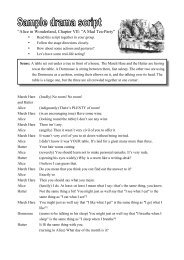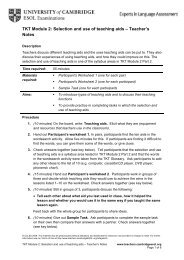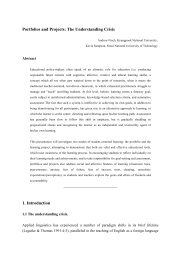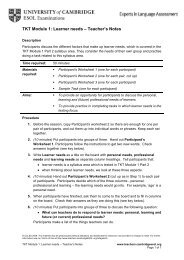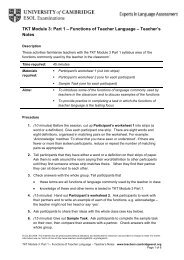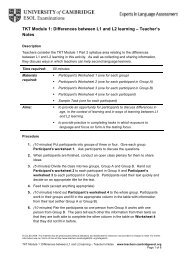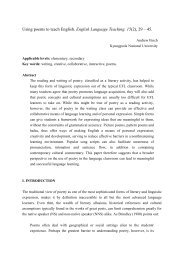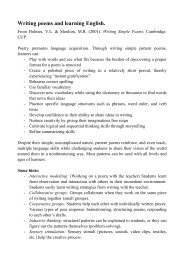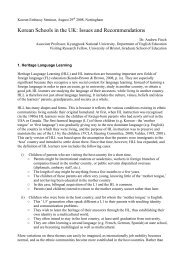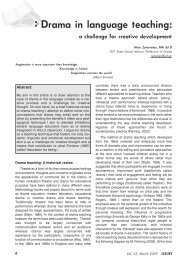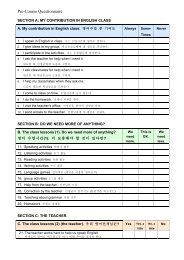Classroom Activity - Finchpark
Classroom Activity - Finchpark
Classroom Activity - Finchpark
Create successful ePaper yourself
Turn your PDF publications into a flip-book with our unique Google optimized e-Paper software.
4. Explain that this syllabus area also tests candidates on their knowledge of ‘the designand purpose of a range of comprehension and production tasks and activities’. Askparticipants:• What do comprehension activities do? (test or develop listening or readingskills and subskills)• What do production tasks and activities do? (provide opportunities forlearners to practise and extend their productive skills, i.e. speaking and writing)5. (10 minutes) Hand out Participant’s worksheet 2. Participants work with theirpartners and choose the correct name for each task from the list at the top of theworksheet. Check answers together (see key below).6. (10 minutes) Refer participants again to the first activity on Participant’s worksheet2 – a survey. Ask:• Is a survey used for testing or developing comprehension or forpractising and extending productive skills? (practising and extendingproductive skills)• Which productive skills? (speaking)• Is this a controlled practice activity, a less controlled practice activity or afree practice activity? That is, how much choice do students have in thelanguage they use? (It depends on the survey. They can be designed topractice specific language (controlled practice or less controlled practice), orthey could be designed to allow students to develop oral fluency (free practice).Sum up by confirming that surveys are used to practise or extend speaking skills andcan be used for controlled practice, less controlled practice or free practice.7. Participants work in pairs again and refer to Exercise 2 on Participant’s worksheet2. Point out that some of the activities may be designed for more than one purpose.Check answers together (see key below).8. (15 minutes) Ask participants to think about lessons they have had and about howactivities can be linked in a lesson. Point out that the types of activities, the ways theactivities are used and how they follow each other in the lesson depends on theapproach, and the ‘framework’ or procedures that the approach uses.9. Participants work in groups of three. Give out Participant’s worksheet 3 Exercise1, and ask participants to fold the worksheet in half along the dotted line (they shouldnot look at Exercise 2 yet). Participants discuss the frameworks/procedures and theactivities that are used for these approaches. Allow 5 minutes for this discussion.10. Participants now unfold Participant’s worksheet 3 and look at Exercise 2. Theycontinue to work in their groups of three and decide which of the approaches go witheach of the frameworks in Exercise 2. Give out Participant’s worksheet 4 forparticipants to check their answers.11. (10 minutes) Give out the Sample Task. Participants complete the task on their ownthen compare their answers with a partner. Check answers together (see key below).© UCLES 2009. This material may be photocopied (without alteration) and distributed for classroom use provided no charge is made. For furtherinformation see our Terms of Use at http://www.teachers.cambridgeESOL.org/ts/legalinfoTKT Module 1: Types of activities and tasks for language and skills development – Teacher’s Noteswww.teachers.cambridgeesol.orgPage 2 of 9
12. (5 minutes) Round up to summarise points covered. Ask participants:• What is the TKT Module 1 syllabus area for this lesson? (types of activitiesand tasks for language and skills development)• What is the testing focus for this syllabus area? (the design and purpose ofa range on common comprehension and production tasks and activities,teaching terms, frameworks for activities and tasks)• How can participants prepare for this section of the test? (look at thesection in the TKT Glossary on practice activities and tasks and make sure thatthey are familiar with the terms and their meanings)© UCLES 2009. This material may be photocopied (without alteration) and distributed for classroom use provided no charge is made. For furtherinformation see our Terms of Use at http://www.teachers.cambridgeESOL.org/ts/legalinfoTKT Module 1: Types of activities and tasks for language and skills development – Teacher’s Noteswww.teachers.cambridgeesol.orgPage 3 of 9
TKT Module 1: Types of activities and tasks for language and skillsdevelopment – Answer KeysKey to Participant’s Worksheet 2 Exercises 1 and 2Exercise 1 Exercise 21. D productionspeaking, controlled practice, less controlled practiceand free speaking.2. F production speaking, controlled practice3. H production speaking, free practice4. K comprehension reading or listening5. E production speaking, free practice6. J comprehension listening7. A production writing, controlled practice or less controlled practice8. B production speaking, less controlled practice or free practice9. I production speaking, free practice10. C production speaking, free practice11. G comprehension readingKey to Sample Task1 A 2 B 3 C 4 A5 A 6 C 7 B© UCLES 2009. This material may be photocopied (without alteration) and distributed for classroom use provided no charge is made. For furtherinformation see our Terms of Use at http://www.teachers.cambridgeESOL.org/ts/legalinfoTKT Module 1: Types of activities and tasks for language and skills development – Answer Keyswww.teachers.cambridgeesol.orgPage 4 of 9
TKT Module 1: Types of activities and tasks for language and skillsdevelopment – Participant’s Worksheet 2Exercise 1Choose one of the task types (A–K) for each of the activities below (1–11).A guided writing B role-play C problem solving D surveyE brainstorming F chant G jumbled text H warmerI rank ordering/prioritising J visualisation K jigsaw listening /reading1. Students find out information from others by asking questions or using questionnaires inorder to practise speaking skills and/or specific language.2. Students repeat a phrase, sentence, rhyme, verse, poem or song, usually with others, ina regular rhythm.3. An activity that a teacher uses at the beginning of a lesson to give the class moreenergy.4. A text is divided into two or more different parts. Students listen to or read their partonly, then share their information with other students so that in the end everyone knowsall the information.5. Students think of ideas (usually quickly) about a topic (often noting these down). This isoften done as preparation before writing or speaking.6. An activity where the teacher asks students to close their eyes and create the pictures intheir minds of the story she is telling them.7. Students produce a text after a lot of preparation by the teacher. The teacher may givethe students a plan to follow, or ideas for the language to use.8. A classroom activity in which students are given parts to act out in a given situation.They usually work in pairs or groups.9. Students are given a list of things to put in order of importance. It involves discussion,agreeing/disagreeing and negotiating.10. Students work in pairs or groups talking together to find the solution to a problem.11. Students are given a text in which the paragraphs or sentences are not in the correctorder. The students put the paragraphs or sentences into the correct order.Exercise 2Look at the activities again. Is the activity a comprehension task or a production task? If it’s acomprehension task, which skill? If it’s a production task, which skill?© UCLES 2009. This material may be photocopied (without alteration) and distributed for classroom use provided no charge is made. For furtherinformation see our Terms of Use at http://www.teachers.cambridgeESOL.org/ts/legalinfoTKT Module 1: Types of activities and tasks for language and skills development – Participant’s Worksheet 2www.teachers.cambridgeesol.orgPage 6 of 9
TKT Module 1: Types of activities and tasks for language and skillsdevelopment – Participant’s Worksheet 4Key to Participant’s worksheet 3 Exercise 2Frameworks for activities and task1. <strong>Activity</strong> with a task and discussion of the task → activity tofocus on language used in the taskApproachesTask-based learning(TBL)2. Grammar rule → students translate a text Grammar-translationmethod3. The teacher presents language items as instructions → thestudents do the actions → the students give the instructions4. Lead in → pre-teach key vocabulary → gist task → detailedcomprehension task → follow up productive activity5. <strong>Activity</strong> with a task to see if students can use a particularstructure → the teacher presents the new language to thestudents → students do another task using new language6. The teacher presents the language in context → controlledpractice activities →less controlled → freer practice7. <strong>Activity</strong> with examples of the target language provided →activity for students to work out language rules for themselves→ activity for students to practice the language8. <strong>Activity</strong> for students to ‘notice’ words or chunks of language →discussion of the meaning of the chunks of language →activity to practise the languageTotal PhysicalResponse(TPR)Skills-based lessonsTest-teach-testPresentation, practiceand production (PPP)Guided discoveryLexical approach© UCLES 2009. This material may be photocopied (without alteration) and distributed for classroom use provided no charge is made. For furtherinformation see our Terms of Use at http://www.teachers.cambridgeESOL.org/ts/legalinfoTKT Module 1: Types of activities and tasks for language and skills development – Participant’s Worksheet 4www.teachers.cambridgeesol.orgPage 8 of 9
TKT Module 1: Types of activities and tasks for language and skillsdevelopment – Sample TaskFor questions 1–7, match the classroom activities with the types of speaking practice listedA, B or C.Mark the correct letter (A, B or C) on your answer sheet.You need to use some options more than onceTypes of speaking practiceABCoral fluency practicecontrolled oral practiceneither<strong>Classroom</strong> activities1 At the beginning of the lesson, we got into groups and talked about an interestingnewspaper article we had read.2 The teacher gave us word prompts such as ‘cinema’ and ‘friends’, and we had tosay them in sentences using the past simple, e.g. ‘We went to the cinema.’ ‘Wevisited some friends.’3 We listened to a recording of two people talking about their hobbies, then did agap-fill comprehension task.4 The teacher gave us roles such as ‘film star’ or ‘sports star’ and we had to role playa party in which we chatted to each other.5 We had a discussion about the advantages and disadvantages of the internet.6The teacher read out some sentences, some of which were correct and someincorrect. We had to shout out ‘Right’ or ‘Wrong’.7We had to ask our partner five questions about abilities, using ‘can’, e.g. ‘Can youswim?’© UCLES 2009. This material may be photocopied (without alteration) and distributed for classroom use provided no charge is made. For furtherinformation see our Terms of Use at http://www.teachers.cambridgeESOL.org/ts/legalinfoTKT Module 1: Types of activities and tasks for language and skills development – Sample Taskwww.teachers.cambridgeesol.orgPage 9 of 9



